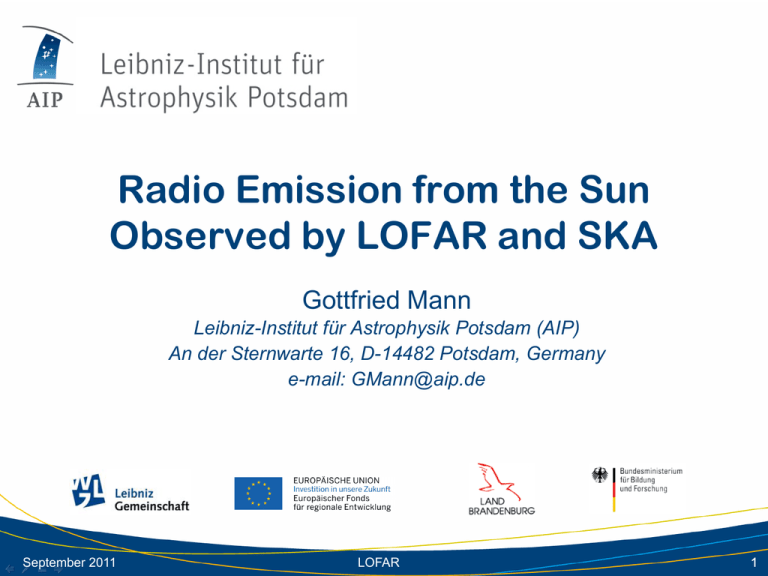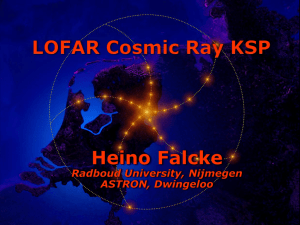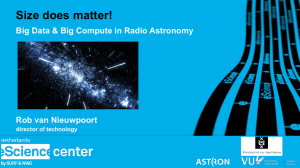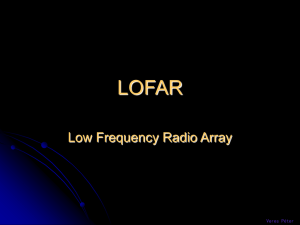Radio Emission from the Sun Observed by LOFAR and SKA
advertisement

Radio Emission from the Sun Observed by LOFAR and SKA Gottfried Mann Leibniz-Institut für Astrophysik Potsdam (AIP) An der Sternwarte 16, D-14482 Potsdam, Germany e-mail: GMann@aip.de September 2011 LOFAR 1 The Flare on October 28, 2003 There is a strong correlation between radio-, hard X-ray and γ-ray emission at large flares, electrons with energies (> 10 MeV) are produced. open question: September 2011 How are 1036 electrons accelerated up to energies > 20 keV within a second? LOFAR 2 Interpretation of Solar Radio Spectra? radio wave emission 30 MHz 1.80 Rs 70 MHz 1.48 Rs 240 MHz 1.17 Rs height from center of the Sun in Mio. km plasma emission f ≈ e2Ne π me heliospheric density model (Mann et al., A&A, 1999) frequency in MHz height =ˆ frequency velocity =ˆ drift rate September 2011 → dynamic radio spectrogram ↔ height-time diagram LOFAR 3 Solar Radio Emission I radio emission from the solar corona – plasma emission - fundamental rad.: Langmuir w. + low freq. plasma w. ωR = ωpe + ωLF ωLF ≤ ωWhistler ≤ 0.1 ωce ⎡ ωce ⎤ ⎢1 + 0.1 ⎥ ≤ 1.01 ωpe ω ⎢⎣ pe ⎥⎦ ωR ≤ ωpe - harmonic emission: → radio wave because of ωpe / ωce > 10 in the corona Langmuir w. + Langmuir w. → radio wave ωR = 2 ωpe index of refraction at the emission site n = 1− n = 0.87 September 2011 ωpe2 2 ω ≤ 0.14 for fundamental emission for harmonic emission LOFAR 4 Solar Radio Emission II law of refraction sin ϑi =n sin ϑr ⎛ sin ϑi ⎞ → ϑr = arcsin ⎜ ⎟ n ⎝ ⎠ → because of total reflection: ϑi ≤ 8° for fundamental emission ϑi ≤ 60° for fundamental emission influence at local density fluctuations (turbulence) n2 = 1 − ωp20 (1 + δ N / N0 ) ωF2 → n = 0.02 − 0.98 δN N0 damping if : 0.02 ≤ δ N / N0 For the fundamental radiation, it is very difficult to leave the emission region in contrast to the harmonic one. September 2011 LOFAR 5 Solar Radio Emission In the solar corona radio waves are emitted by plasma emission. Due to density fluctuations in the corona, the spatial resolution is reduced to few 10”. LOFAR’s core stations and first ring of remote stations are sufficient for solar observations. September 2011 LOFAR 6 LOFAR as Pathfinder for SKA LOFAR: LOw Frequency ARray • 30 – 240 MHz • • LBA: 30 – 80 MHz HBA: 120 – 240 MHz September 2011 • • • LOFAR 22 core stations in NL 18 remote stations in NL 8 international remote stations (one in Potsdam-Bornim/AIP) 7 LOFAR Onsala Exloo Chilbolton Potsdam Jülich Tautenburg Effelsberg Garching Nancay September 2011 LOFAR 8 First LOFAR Image of the Sun Radio image of the Sun (left) at 135 MHz as obtained by LOFAR on June 9, 2010. An EUV(middle) and soft X-ray image (right) of the Sun as simultaneously provided by the Solar Dynamics Observatory (AIA at 17,1 nm) and Hinode (XRT) is presented for comparison. Active region (enhanced radio emission) and polar coronal wholes (reduced emission) are well seen. September 2011 LOFAR 9 First Radio Burst Observed by LOFAR I (March 17, 2011) September 2011 LOFAR 10 First Radio Burst Observed by LOFAR II (March 17, 2011) September 2011 LOFAR 11 First Radio Burst Observed by LOFAR III (March 17, 2011) Magnetic reconnection generates a hot plasma jet (→ radio burst) (Miteva, Mann & Vocks, 2008) September 2011 LOFAR 12 Solar Physics with LOFAR and SKA SKA and LOFAR as ist pathfinder allows a 3D tomography of the solar radio activity in the corona scientific objectives: - magnetic energy release electron acceleration plasma jets shock waves solar energetic particle events - coronal mass ejections (CMEs) Inst. CMEs influence our Earth s environment and technical civilisation refer to: → Space Weath LOFAR-KSP Solar Physics and Space Weather with LOFAR http://www.aip.de/groups/osra/german/de_lofar.html September 2011 LOFAR 13 Summary SKA and LOFAR as ist pathfinder are of great interest for solar physics, since these instruments allow a 3D tomography of the solar activity in the corona. Solar radio astronomy can study plasma processes related energetic electrons. That can never be done by other instruments. These processes are of special interest, since they are able to influence our Earth's environment and our technical civilization, which is usually called Space Weather. Thank you for your attention ! September 2011 LOFAR 14 LOFAR LBA: 30 – 80 MHz HBA: 120 – 240 MHz 96 antennas 4 x 4 x 96 antennas All stations are connected with high data trasfer (10 Gbit/s) link with Groningen, where the data are correlated. September 2011 LOFAR 15 Key Science Project Solar Physics and Space Weather with LOFAR 31 participants from 11 countries September 2011 1st workshop Oct. 5/6, 2006 2nd workshop June 24/25, 2009 3rd workshop July 5/6, 2010 4th workshop Nov. 8/9, 2010 5th workshop June 28-30, 2011 LOFAR 16



